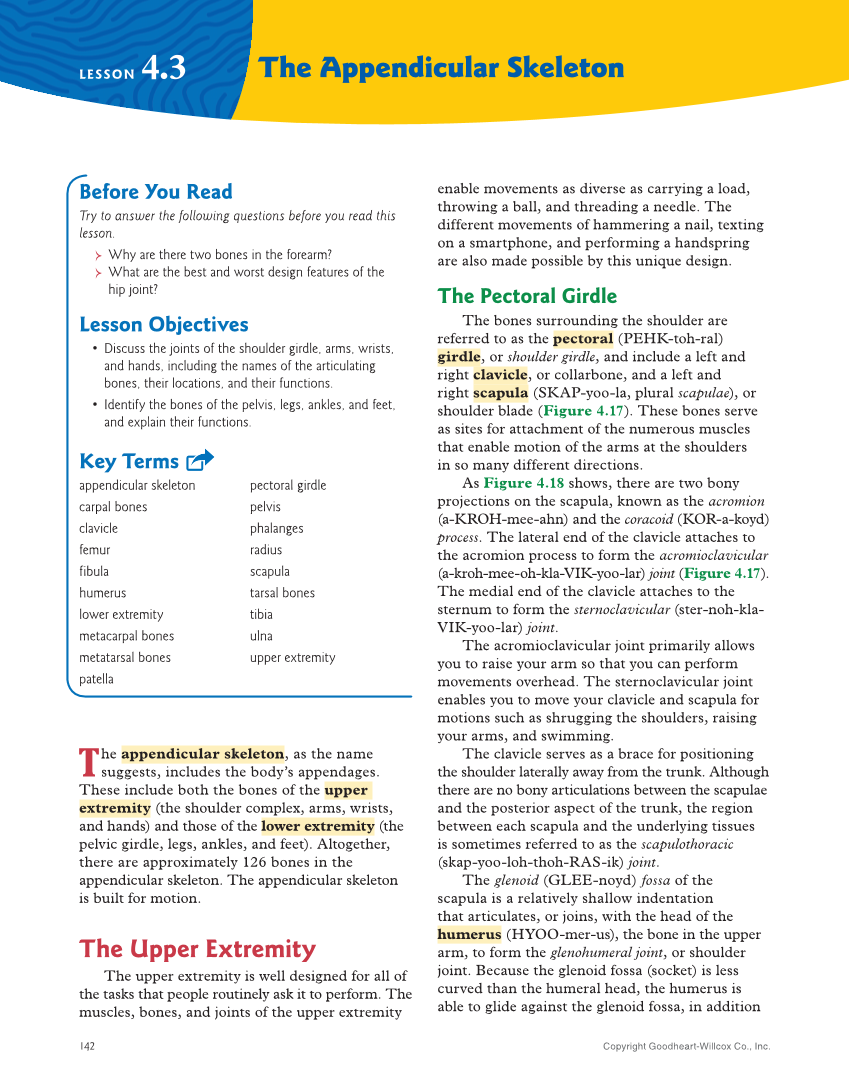142 The Appendicular Skeleton LESSON 4.3 enable movements as diverse as carrying a load, throwing a ball, and threading a needle. The different movements of hammering a nail, texting on a smartphone, and performing a handspring are also made possible by this unique design. The Pectoral Girdle The bones surrounding the shoulder are referred to as the pectoral (PEHK-toh-ral) girdle, or shoulder girdle, and include a left and right clavicle, or collarbone, and a left and right scapula (SKAP-yoo-la, plural scapulae), or shoulder blade (Figure 4.17). These bones serve as sites for attachment of the numerous muscles that enable motion of the arms at the shoulders in so many different directions. As Figure 4.18 shows, there are two bony projections on the scapula, known as the acromion (a-KROH-mee-ahn) and the coracoid (KOR-a-koyd) process. The lateral end of the clavicle attaches to the acromion process to form the acromioclavicular (a-kroh-mee-oh-kla-VIK-yoo-lar) joint (Figure 4.17). The medial end of the clavicle attaches to the sternum to form the sternoclavicular (ster-noh-kla- VIK-yoo-lar) joint. The acromioclavicular joint primarily allows you to raise your arm so that you can perform movements overhead. The sternoclavicular joint enables you to move your clavicle and scapula for motions such as shrugging the shoulders, raising your arms, and swimming. The clavicle serves as a brace for positioning the shoulder laterally away from the trunk. Although there are no bony articulations between the scapulae and the posterior aspect of the trunk, the region between each scapula and the underlying tissues is sometimes referred to as the scapulothoracic (skap-yoo-loh-thoh-RAS-ik) joint. The glenoid (GLEE-noyd) fossa of the scapula is a relatively shallow indentation that articulates, or joins, with the head of the humerus (HYOO-mer-us), the bone in the upper arm, to form the glenohumeral joint, or shoulder joint. Because the glenoid fossa (socket) is less curved than the humeral head, the humerus is able to glide against the glenoid fossa, in addition Before You Read Try to answer the following questions before you read this lesson. Why are there two bones in the forearm? What are the best and worst design features of the hip joint? Lesson Objectives • Discuss the joints of the shoulder girdle, arms, wrists, and hands, including the names of the articulating bones, their locations, and their functions. • Identify the bones of the pelvis, legs, ankles, and feet, and explain their functions. Key Terms appendicular skeleton carpal bones clavicle femur fibula humerus lower extremity metacarpal bones metatarsal bones patella pectoral girdle pelvis phalanges radius scapula tarsal bones tibia ulna upper extremity The appendicular skeleton, as the name suggests, includes the body’s appendages. These include both the bones of the upper extremity (the shoulder complex, arms, wrists, and hands) and those of the lower extremity (the pelvic girdle, legs, ankles, and feet). Altogether, there are approximately 126 bones in the appendicular skeleton. The appendicular skeleton is built for motion. The Upper Extremity The upper extremity is well designed for all of the tasks that people routinely ask it to perform. The muscles, bones, and joints of the upper extremity Copyright Goodheart-Willcox Co., Inc.
